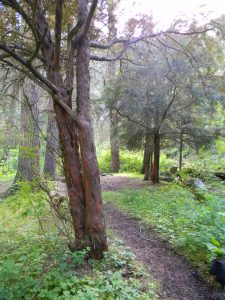
(Taxus Brevifolia)
Physical Characteristics: Small tree 3 – 15 meters high with a diameter up to 30 – cm. Papery-reddish bark with droopy branches and twisted/fluted trunk. Flat needles 2 – 3 cm long. Leaves are green on top and striped with a stomata below; ends abruptly in fine point, arranged in two rows in flat sprays. Single bony seed mostly surrounded by bright red/fleshy cup that looks like large red huckleberry with a hole in the end (poisonous to humans).
Habitat: Grows in various environments – sun and shade tolerant. Mostly limited to stream-side habitats in drier environments. Can form an understory and provide shade/cooler water temperatures. Will grow on slopes and ridgetops in wetter environments.
Range: Southernmost Alaska to southeast British Columbia and south to central California, mostly occurring in Cascades and Sierra Nevada Mountains. Also found throughout Clearwater Basin; considered Coastal Disjunct species.
Reproduction: Considered dioecious – production is biparental; seeds produced on female tree and pollen produced on male tree. Seeds are forced to travel to germinate; birds mainly disperse. Seeds may remain dormant for years in soil and grow when conditions are favorable. Pollen mainly dispersed by wind. Male/female cones are inconspicuous; found on separate trees.
Threats: Heavily exploited for its bark; recent efforts have reduced exploitation. Logging and wildland fire have also played a role reduction.
Miscellaneous: Organic compound named Taxol has been recently discovered in trees. Compound shown to help treatment of breast/ovarian cancers.
Return to main Native Species page.